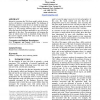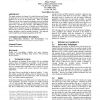W4A
2006
ACM
14 years 9 months ago
2006
ACM
At its most basic, the web allows for two modes of access: visual and non-visual. For the most part, our design attention is focused on making decisions that affect the visual, or...
W4A
2006
ACM
14 years 9 months ago
2006
ACM
Cellular phones have already been widely used to access the Web. However, most existing Web pages are designed for desktop PCs, and thus, it is inconvenient to browse these large ...
W4A
2006
ACM
14 years 9 months ago
2006
ACM
Graphical representations are a powerful way of conveying information. Their use has made life much easier for most sighted users, but people with disabilities or users who work i...
W4A
2006
ACM
14 years 9 months ago
2006
ACM
While mobile phones are becoming more popular, wireless communication vendors and device manufacturers are seeking new applications for their products. Access to the large corpus ...
W4A
2006
ACM
14 years 9 months ago
2006
ACM
Recent developments in the mobile phone market have led to a significant increase in the number of users accessing the Mobile Internet. Handsets have been improved to support a d...
W4A
2006
ACM
14 years 9 months ago
2006
ACM
This paper discusses extensions to the previously developed “essentiality and proficiency” approach to increasing usability and accessibility of websites. The existing approa...
W4A
2006
ACM
14 years 9 months ago
2006
ACM
While many of the issues that are being raised in relation to mobile web accessibility are similar or the same to those that have been promoted over the past few years in relation...
W4A
2006
ACM
14 years 9 months ago
2006
ACM
Interest in accessing the Web from small, mobile devices, such as cell phones, is increasing rapidly. The challenge of delivering content to such devices is similar in many ways t...
W4A
2006
ACM
14 years 9 months ago
2006
ACM
W4A
2006
ACM
14 years 9 months ago
2006
ACM
This paper examines the degree of overlap between for physical ease of access on the Web in general, and physical ease of use on the mobile Web. There differences in the basic int...





